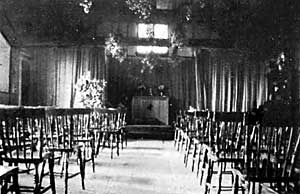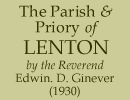< The parish register | Contents | Places >
19.—LENTON SCHOOLS AND PAROCHIAL HALLS.
One of the first schools in Lenton was kept by John Roughton in the room of a house in Gregory Street. There was also a Dame's school in Abbey Street, to which Sir John Turney went at the cost of two-pence per week to his parents.
The National Schools.
The National Schools, with the master's and mistress's residences, built of brick with stone facings, and situated in Church Street, were erected in 1841 at the cost of £2,305, the site having been given by Francis Wright. These were extended in 1855 by two-thirds, on the recommendation of Dr. Langford, H.M. Inspector of Schools, in consequence of the greatly increased attendance in the Boys' School. An Infant School was erected in 1851 at the expense of the Misses C. and A. Wright, of Lenton Lodge. This school was built in Church Street by the railway bridge. There was a level crossing at that time. When the bridge was built, Church Street was slightly diverted. It previously ran past the west gate of the churchyard. The remaining strip comes to an end at the railway and serves as an approach to the west gate. The crossing keeper's house remains standing. In 1896 this school was enlarged at the cost of £1,579, and became the Boys' School, the Infant School being transferred to the older buildings. The opening ceremony was performed by the Lord Bishop of Southwell, who was accompanied by Lady Laura Ridding.
The schools are under the control of a Trust of which the Vicar of Lenton is the Chairman. Church teaching is an important part of the curriculum of the schools, in which the clergy give their assistance. A Day Schools service is held in church on alternate Mondays.
Holy Trinity Mission Hall, Manfull Street.
Erected by the Misses Wright in 1873 at a cost of £660, it was intended that the Mission Hall in Manfull Street should be used by the church for parochial purposes, and as a centre for the missionary and evangelistic work of the parish. For many years it degenerated into a sort of billiard hall, but has now been restored to its original use. In 1929 the Hall was completely renovated and repaired, and minor alterations were carried out. It is now the centre of much valuable work.
The Priory Hall, Old Lenton.
 |
The temporary church hall at Lenton Abbey (S. Barnanabas). |
This Hall, which adjoins the Priory churchyard, was built in 1826 by the
Wesleyan Connexion. It was sold in 1853 to the Primitive Methodists, when
the Wesleyans built their new church. The Primitive Methodists, in their
turn, built a new church in Abbey Street and accordingly sold the old chapel
to Lenton Parish Church for the sum of £225, secured by the generous
donations of Mrs. Sherwin Gregory, the Misses Wright, and Frederick Wright.
It is used in connection with the Priory Church and serves the purpose of
a Sunday School, and the centre for many other organizations. Prior to the
purchase of the Hall in 1883, the Sunday School was held in the chancel of
the church. The Hall was thoroughly repaired and improved with a view to
its being used as a Day as well as a Sunday School for Old Lenton. It does
not appear to have ever been used as a Day school however. It was enlarged
in 1929 at the cost of about £600, and electric light was installed.
S. Barnabas, Lenton Abbey.
Previous to the building of S. Barnabas' Church Hall, Services and a Sunday School had been held in a building adjoining Lenton Abbey. The site on which this temporary Church Hall is built was purchased for the parish by the Diocesan Board of Finance. The Hall was erected in 1930, and opened on the 8th of March that year by W. G. Player, Esq., of Whatton Manor, the donor of the bulding. A substantial structure of wood, asbestos lined, it is placed upon a brick foundation, and seats about 200 people. About 300 people werepresent at the opening ceremony, when the Lord Mayor of Nottingham (Councillor Walter Wesson), a Lentonian, took the Chair. The Rt. Rev. the Lord Bishop of Southwell (Dr. Henry Mosley) dedicated the Holy Table, a portable oak one, the gift of the builder, Mr. J. Norris. Many other gifts have been received since the Hall was opened, including a gift of 50 chairs by Mrs. Littlewood, 200 Prayer and Hymn Books, by Mrs. W. G. Player, and Mr. C. Mony, an organ and a beautiful solid brass cross for the Holy Table by Mr. Cyril Ball, and an oak pulpit-lectern, made and presented by Mr. Sydney R. Edwards.
The erection of a permanent Church Hall, and Parsonage house on this site, is part of the scheme for church extension in the parish.
20.—LENTON FEAST OR WAKES.
Each Parish Feast or Wakes, as the words imply, should be kept at the Feast of the Dedication of the Parish Church. The Feast is the feast simply, and the Wakes is an extension or continuation of the waking or watching through the Vigil or night preceding the great feast, which was observed in the early days of the church. If a church feast is not kept at the feast of the dedication of the church, history ought to say why, and that portion of parochial information be made as public as possible. The subject is a most interesting one. Lenton Feast, what there is of it, is now kept at Whitsuntide, but it has only been kept so since 1805. The Priory being dedicated about 1100 to the Holy and Undivided Trinity, the Festival was always kept from that time at Trinitytide. In 1805 for no apparent reason, it was decided to observe the Feast at Whitsuntide. We have the following note about this, but it gives no reason for the change except that it was desirable.
"The village feast or wakes was formerly held on Trinity Sunday, but at a meeting of the inhabitants convened for the purpose of taking into consideration the propriety of altering the annual feast from Trinity Sunday to Whit-Sunday held in the Parish Church on April 15th, 1805, it was resolved unanimously as the opinion of this meeting that it is desirable that the annual feast which has hitherto been held in Trinity week shall be kept in Whitsun week for the future, and also that an advertisement declaratory to be twice inserted in the Nottingham Journal and that the Lord of the Manor, the Minister of the Church, and the churchwardens and overseers to be requested to sign the advertisement." The note goes on to say, "This alteration was duly carried out and the feast is normally observed at Whitsuntide."
20.–NOTE ON CHURCH EXTENSION IN THE PARISH OF LENTON.
By the Rev. R. J. R. SKIPPER, Vicar of Lenton.
The opening up of two new housing estates within the last few years—those of Wollaton Park and Lenton Abbey—has meant a rapid increase in the population of the parish by many thousands. The parish is therefore faced with the problem of raising large sums of money for church buildings in each of these districts. So far, a temporary Hall has been erected at Lenton Abbey, on a site acquired for the parish by the Diocesan Board of Finance, and land secured for a Church and Church Hall at Wollaton Park—the generous gift of a private donor, who also met the cost of the temporary structure at Lenton Abbey. The immediate need is for a permanent Church Hall to be erected on the site in Wollaton Park, and a more permanent building at Lenton Abbey, which at the very lowest figure means the raising of £6,000; but £25,000 at least will be required to carry out all that is needed in the district.
It is interesting to note that the Communion Plate, which is all silver, and consists of a flagon, two patens, and two cups, and also the Oak Eagle Lectern, and the Font, from the dismantled church of S. Thomas', Park Row, Nottingham, have been presented to the parish by the Bishop, for use in one or other of the new churches when erected.
< The parish register | Contents | Places >
